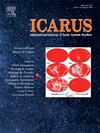Amundsen-Ganswindt盆地:一个被忽视的月球峰环盆地,具有多种勘探机会
IF 3
2区 物理与天体物理
Q2 ASTRONOMY & ASTROPHYSICS
引用次数: 0
摘要
直径约355 km的Amundsen-Ganswindt撞击盆地(81°S, 120°E)已被地层限制为南极-艾特肯盆地地体中最古老的大型盆地。它部分与阿尔忒弥斯勘探带重叠,在那里沉积了大量的撞击喷出物沉积物。该盆地高度退化,部分与类似大小的Schrödinger峰环撞击盆地重叠,这导致之前的工作人员质疑它是否含有原始峰环的残留物。我们对Amundsen-Ganswindt盆地进行了详细的地质研究,并在全球月球探测目标的背景下评估了这个古老结构的科学潜力,这些目标为未来的月球南极地区载人和机器人探测任务奠定了基础。我们以1:10万的比例绘制了该盆地的地图,并确定了高价值的勘探目标,包括原始峰环的残余物和对这种隆起物质进行取样的机会。考虑到它的年龄,阿蒙森-甘斯温特的峰环和喷出物沉积物将含有很大比例的来自南极-艾特肯盆地的物质。此外,来自Schrödinger峰环撞击盆地(月球上第二年轻的盆地)的物质也可用于采样。形态学证据表明,Amundsen-Ganswindt盆地影响了Schrödinger边缘和峰环的最终形态。阿蒙森-甘斯温特盆地还拥有巨大的、可进入的永久阴影区域,轨道上可以探测到水冰。因此,我们建议被忽视的Amundsen-Ganswindt盆地是未来机器人和人类勘探任务的特殊勘探目标。本文章由计算机程序翻译,如有差异,请以英文原文为准。
The Amundsen-Ganswindt basin: An overlooked lunar peak-ring basin with multiple exploration opportunities
The ∼ 355 km diameter Amundsen-Ganswindt impact basin (81°S, 120°E) has been stratigraphically constrained as the oldest large basin in the South Pole-Aitken basin terrane. It partly overlaps the Artemis Exploration Zone, across which it deposited significant volumes of impact ejecta deposits. The basin is highly degraded and partially superposed by the similar-sized Schrödinger peak-ring impact basin, leading previous workers to question whether it contains any remnants of an original peak-ring. We have conducted a detailed geologic study of the Amundsen-Ganswindt basin and evaluated the scientific potential of this ancient structure in the context of global lunar exploration objectives that underpin future crewed and robotic exploration missions to the lunar south polar region. We have mapped the basin at a scale of 1:1,000,000 and identified high-value exploration targets, including remnants of an original peak ring and opportunities to sample this uplifted material. Given its age, both Amundsen-Ganswindt's peak ring and ejecta deposits will contain a high proportion of material from the South Pole-Aitken basin. In addition, material from the Schrödinger peak-ring impact basin — the second youngest basin on the Moon — are also available for sampling. Morphological evidence suggests that the Amundsen-Ganswindt basin influenced the final morphology of Schrödinger's rim and peak ring. The Amundsen-Ganswindt basin is also host to large, accessible permanently shadowed regions with orbital detections of water ice. Thus, we propose that the overlooked Amundsen-Ganswindt basin is an exceptional exploration target for future robotic and human exploration missions.
求助全文
通过发布文献求助,成功后即可免费获取论文全文。
去求助
来源期刊

Icarus
地学天文-天文与天体物理
CiteScore
6.30
自引率
18.80%
发文量
356
审稿时长
2-4 weeks
期刊介绍:
Icarus is devoted to the publication of original contributions in the field of Solar System studies. Manuscripts reporting the results of new research - observational, experimental, or theoretical - concerning the astronomy, geology, meteorology, physics, chemistry, biology, and other scientific aspects of our Solar System or extrasolar systems are welcome. The journal generally does not publish papers devoted exclusively to the Sun, the Earth, celestial mechanics, meteoritics, or astrophysics. Icarus does not publish papers that provide "improved" versions of Bode''s law, or other numerical relations, without a sound physical basis. Icarus does not publish meeting announcements or general notices. Reviews, historical papers, and manuscripts describing spacecraft instrumentation may be considered, but only with prior approval of the editor. An entire issue of the journal is occasionally devoted to a single subject, usually arising from a conference on the same topic. The language of publication is English. American or British usage is accepted, but not a mixture of these.
 求助内容:
求助内容: 应助结果提醒方式:
应助结果提醒方式:


